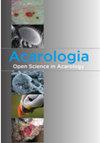Effects of temperature on life table parameters of a newly described phytoseiid predator, Neoseiulus neoagrestis (Acari: Phytoseiidae) fed on Tyrophagus putrescentiae (Acari: Acaridae)
IF 1.1
3区 农林科学
Q3 ENTOMOLOGY
引用次数: 2
Abstract
The predatory mite, Neoseiulus neoagrestis Khaustov and Döker (Acari: Phytoseiidae), recently described as new species for science, but seems to have a great potential to be used in biological control. In this study, as a first step to determine the optimum temperature (between three temperatures tested) for its mass rearing, we studied its biological characteristics and life table parameters fed on Tyrophagus putrescentiae (Schrank) (Acari: Acaridae) at three different temperatures (20, 25, and 30 °C) under laboratory conditions. Results show that immature development, oviposition period as well as reproductive potential of this predator are significantly vary depending on the temperature. The immature developmental times and adult longevity for females, are ranged between 5.42 to 10.42 days and 39.88 to 74.12 days, based on the temperature, respectively. Average total number of eggs laid by per female at 25 °C (62.29) and 30 °C (58.65) are more or less similar but higher than that determined at 20 °C (41.46). The highest net reproductive rate (R0) is 29.066 (offspring/individual) at 25 °C. In addition, the highest intrinsic rate of natural increase (r) is 0.241 day-1 at 30 °C. Furthermore, the highest finite rate of increase (λ = 1.272 day-1), and the shortest mean generation time (T = 13.416 days) and doubling time (DT = 2.874 days) are also determined at 30 °C. Our results demonstrate that N. neoagrestis successfully completed immature development, and can survive and reproduce at all tested temperatures. Nevertheless, a series of biological characteristics of this predator are differentially affected by the temperature. Finally, 25 °C and 30 °C seems to be more suitable for mass rearing of this predator on T . putrescentiae. Further studies should be conducted to determine biological characteristics and life table parameters of N. neoagrestis on several important pests such as spider mites, whiteflies and thrips.温度对一种新描述的以腐败Tyrophagus putrescentiae(Acari:Acadidae)为食的植物性食腐动物Neoseulus neoagrestis(Acari:Phytoseidae)生命表参数的影响
捕食性螨Neoseulus neoagrestis Khaustov和Döker(Acari:Phytoseidae)最近被描述为科学上的新物种,但似乎在生物控制中有很大的潜力。在本研究中,作为确定其大规模饲养的最佳温度(在测试的三个温度之间)的第一步,我们在实验室条件下,在三个不同温度(20、25和30°C)下,研究了其以腐败Tyrophagus putescentiae(Schrank)(Acari:Acaridae)为食的生物学特性和生命表参数。结果表明,这种捕食者的未成熟发育、产卵期和繁殖潜力随温度的变化而变化很大。根据温度,雌性的未成熟发育时间和成年寿命分别在5.42至10.42天和39.88至74.12天之间。每只雌性在25°C(62.29)和30°C(58.65)下的平均产卵总数或多或少相似,但高于20°C(41.46)下的产卵总数。25°C下的最高净繁殖率(R0)为29.066(后代/个体)。此外,在30°C时,自然增长的最高固有速率(r)为0.241天-1。此外,在30°C下还确定了最高的有限增长率(λ=1.272天-1)、最短的平均生成时间(T=13.416天)和倍增时间(DT=2.874天)。我们的研究结果表明,N.neoagrestis成功地完成了未成熟发育,并且可以在所有测试温度下存活和繁殖。然而,这种食肉动物的一系列生物学特征都受到温度的不同影响。最后,25°C和30°C似乎更适合在T上大规模饲养这种捕食者。腐败。应进行进一步的研究,以确定N.neoagrestis对蜘蛛螨、粉虱和蓟马等几种重要害虫的生物学特性和生命表参数。
本文章由计算机程序翻译,如有差异,请以英文原文为准。
求助全文
约1分钟内获得全文
求助全文
来源期刊

Acarologia
ENTOMOLOGY-
CiteScore
2.00
自引率
18.20%
发文量
81
期刊介绍:
Acarologia is a free open-access journal. Please help us by submitting manuscripts in accordance with following instructions.
All manuscripts which do not conform to the instructions will be returned to authors without the benefit of review.
Acarologia publishes the results of original research on all aspects of Acarology.
The journal policy is that taxonomic descriptions should include several species within a same genus/family, when possible.
The editors reserve the right to refuse manuscripts when authors intentionally divide individual species descriptions of the same genus/family into distinct publications.
Single species descriptions should be clearly justified based on their scientific interest.
 求助内容:
求助内容: 应助结果提醒方式:
应助结果提醒方式:


